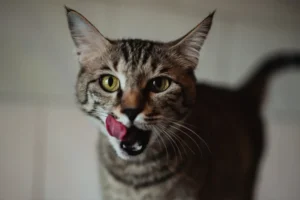Cats are known for their adorable whiskers, but have you ever wondered why those whiskers are curly? Let’s explore the fascinating reason behind this unique feature.
What are Cat Whiskers Made of?
Cat whiskers, also known as vibrissae, are not your average fur strands. They are actually much thicker and stiffer than regular fur, thanks to being composed of a protein called keratin. This robust protein gives them their strength and durability, allowing them to withstand daily wear and tear.
But here’s where it gets interesting – cat whiskers are embedded deeper into a cat’s body than regular fur, reaching down to the nerve endings. This unique positioning is what gives them their remarkable sensitivity and allows cats to navigate the world with precision and grace.
The Function of Cat Whiskers
Cat whiskers may seem like simple facial adornments, but they serve a vital function beyond just looking cute. These specialized hairs are finely tuned instruments that help cats sense the world around them in ways we can only imagine.
One of the primary functions of cat whiskers is to act as tactile sensors, providing valuable information about the cat’s surroundings. These whiskers are so sensitive that they can detect even the slightest changes in air currents, alerting the cat to potential dangers or prey nearby.
Moreover, cat whiskers also play a crucial role in a cat’s spatial awareness. By extending and retracting their whiskers, cats can gauge the width of openings and determine if they can squeeze through tight spaces without getting stuck. This remarkable ability to measure distances using their whiskers is a testament to the incredible adaptability and intelligence of our feline friends.
Next time you marvel at your cat’s whiskers, remember that these seemingly simple hairs are actually sophisticated tools that help them navigate the world with finesse and finesse.
The Development of Curly Whiskers
Have you ever noticed how some cats have curly whiskers while others don’t? The reason behind this fascinating trait lies in their genetic makeup. Curly whiskers are believed to be the result of a genetic mutation that affects the shape and texture of the whisker follicles. These mutations can cause the whiskers to grow in a curly, wavy, or even spiral pattern, giving the cat a unique and distinctive look.
Interestingly, curly whiskers can also provide some evolutionary advantages for cats. The curly shape of the whiskers may enhance their sensitivity, allowing cats to better navigate their surroundings and detect subtle changes in their environment. This heightened sensory ability can be particularly beneficial for cats that rely on their whiskers for hunting or exploring unfamiliar territory.
So, the next time you see a cat with curly whiskers, remember that it’s not just a quirky aesthetic feature – it’s a fascinating genetic adaptation that has evolved to help cats thrive in their environments.
Additional Insight:
Curly whiskers in cats can also be influenced by breed-specific characteristics. Some cat breeds are more predisposed to having curly whiskers due to their genetic history and breeding practices. So, if you have a curly-whiskered cat, it might be interesting to research its breed’s background to understand more about this unique trait.
Similarities with Other Animals
Cat whiskers are not just unique to felines – many other animals have similar sensory hairs that serve important functions in their daily lives. While the exact structure and length of whiskers can vary between species, their primary role remains consistent across the animal kingdom.
For example, whiskers in rodents like mice and rats are essential for their spatial awareness and navigation, similar to how whiskers help cats with their hunting and exploration. Whiskers in seals and walruses are crucial for detecting prey underwater, highlighting their significance in different environments and ecosystems.
By exploring the similarities in whisker functions across various animals, we gain a deeper appreciation for these specialized sensory organs and the vital roles they play in helping animals survive and thrive in their habitats.
Fun Fact:
Did you know that some birds, like owls and herons, also have whisker-like structures called “rictal bristles” around their beaks? These specialized feathers help birds sense and catch prey with incredible precision, showcasing how whisker-like adaptations can be found in surprising places in the animal kingdom.
Fun Facts About Cat Whiskers
Cat whiskers are not just ordinary facial hair; they serve a crucial purpose in helping our feline friends navigate their surroundings. These specialized hairs, known as vibrissae, are incredibly sensitive and can detect even the slightest changes in air currents. When a cat is exploring a tight space, their whiskers can help them determine if they can fit through it.
Did you know that cat whiskers are as wide as the cat’s body? This unique feature allows them to gauge whether they can squeeze into a space without getting stuck. Additionally, whiskers also help cats with their social interactions – they can communicate their mood through the positioning of their whiskers.
Another fascinating fact is that cat whiskers are not only found on the face; they also grow on the back of the legs. These leg whiskers, known as carpal whiskers, provide crucial information about the cat’s surroundings while they are stalking prey or moving through dark spaces. Overall, cat whiskers are multifunctional and play a vital role in a cat’s daily life.
Can Cat Whiskers Straighten?
Curious about whether cat whiskers can straighten? While a cat’s whiskers can bend or flex slightly, they are naturally rigid and do not have the ability to straighten out over time. Whiskers are made of keratin, the same protein that makes up human hair and nails, which gives them their stiffness and durability.
However, if a cat’s whiskers appear bent or damaged, it’s vital to ensure they are not trimmed or pulled out, as this can disorient and stress the cat. Whiskers naturally shed and regrow over time, so it’s essential to let this process occur naturally to maintain a cat’s sensory capabilities.
Remember, whiskers are not just a cute feature on cats; they are essential tools that help them navigate their environment with precision and grace. So next time you marvel at your cat’s whiskers, know that they play a vital role in their daily lives.
How to Care for Cat Whiskers
Cat whiskers are not just cute accessories on your feline friend’s face; they serve a crucial purpose in helping cats navigate their surroundings. To keep your cat’s whiskers in top shape, avoid trimming them as they are sensitive and play a vital role in sensory perception.
Ensure your cat’s environment provides enough space for their whiskers to move freely without being compressed. Avoid using tight collars or narrow spaces that can bend or break the delicate whiskers. Keep an eye out for any signs of damage or irritation, such as broken or frayed whiskers, which may indicate potential health issues.
Regular grooming can also help maintain your cat’s whiskers. Gentle brushing around the whisker area can prevent dirt and debris from accumulating and keep the whiskers clean. Remember, whiskers are not like regular hairs and should not be pulled or tugged.
Remember, whiskers are like a cat’s own personal radar system, so take care to protect and respect these sensitive sensory tools to keep your feline friend happy and healthy.
The Importance of Cat Whiskers in Communication
Cat whiskers are not just for show; they are an essential part of a cat’s communication toolkit. Whiskers are highly sensitive and can detect even the slightest changes in the environment, helping cats navigate and understand the world around them.
When a cat is feeling curious or excited, their whiskers may point forward, showing their interest in something. On the other hand, when they are feeling threatened or scared, their whiskers may flatten against their face to make them appear smaller and less intimidating.
In addition to communication with their environment, cat whiskers can also help cats communicate with other animals and even with their humans. Understanding and respecting your cat’s whiskers can strengthen the bond between you and your feline companion.
Remember, whiskers are not just a cute feature on your cat’s face; they are essential tools for communication and navigation in their daily lives. Treat them with care and respect to ensure your cat stays happy and healthy.
The Myth Behind Curly Cat Whiskers
Have you ever heard the myth that a cat’s whiskers are curly because they can predict earthquakes? Well, let’s debunk that right away! The truth is, cats’ whiskers are curly not because they have some mystical power, but because of their unique structure.
Unlike human hair, a cat’s whiskers are deeply rooted in their body and are actually connected to their nervous system. These specialized hairs are called vibrissae, and they are incredibly sensitive, helping cats navigate their surroundings with precision.
Now, let’s set the record straight – cats with curly whiskers are not magical earthquake detectors. They simply have evolved this way to enhance their sensory abilities and help them better understand the world around them. So next time you see a cat with curly whiskers, remember it’s not because they have special powers, but because nature has equipped them for survival.
Fun Fact:
Did you know that a cat’s whiskers are roughly as wide as its body? This allows them to gauge whether they can fit through tight spaces without getting stuck. Pretty cool, right?
Uncover the Science of Curly Cat Whiskers
When it comes to understanding why cats have curly whiskers, it all boils down to science. The unique shape of a cat’s whiskers plays a crucial role in how they gather information about their environment. The slight curl in the whiskers actually helps to amplify the signals they receive, making it easier for them to detect subtle changes in their surroundings.
Additionally, the curvature of the whiskers helps cats determine the distance between objects, aiding in their spatial awareness. So, next time you marvel at a cat’s curly whiskers, remember that it’s not just a quirky trait – it’s a vital tool that helps them navigate the world around them.
Key Insight:
Cats use their whiskers to gauge the size of openings and assess whether they can comfortably pass through narrow spaces. This is why it’s important not to trim or cut their whiskers, as it can disrupt their ability to move around safely.
Alex, a passionate animal lover, has experience in training and understanding animal behavior. As a proud pet parent to two dogs and three cats, he founded AnimalReport.net to share insights from animal experts and expand his knowledge of the animal kingdom.









